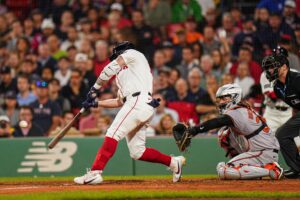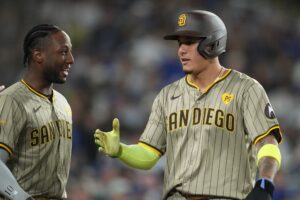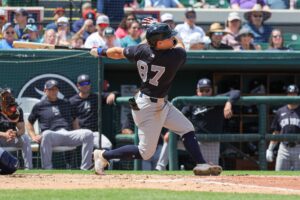For the past few years, regardless of lackluster preseason predictions, A’s fans have been able to hold onto one thing- their come from behind, unforgettable 2012 season. Pitchers not completely healthy? It’s ok, remember Brett Anderson in 2012? Predicted to lose 100 games? Don’t worry, they said that in 2012. Finished well below .500 in the previous season? So did the 2012 squad. Eight games under .500? That’s nothing. Remember 2012? 13 games out of first place? Piece of cake. Remember 2012.
With positive changes in the front office and the new slogan #RootedinOakland, the fan base is re-energized and filled with more optimism than ever. While non-baseball operations feel like a dream come true, is it realistic to use 2012 as a rallying cry for the on-field product? Should we start the hashtag #Remember2012?
Here I compare the Oakland A’s 2012 Opening Day lineup to a potential 2017 Opening Day lineup. Rather than including stats from the 2012 season, I am comparing the stats the Opening Night starters had entering the 2012 season with the stats this season’s players have entering the 2017 season. This way we can see if there is still potential for another surprisingly successful season full of walk-off wins, incredible team chemistry, and emerging stars.
Can the 2017 Oakland Athletics Re-Create their Unforgettable 2012 Season?
Catchers: Kurt Suzuki and Stephen Vogt
Kurt Suzuki (2012): Suzuki entered the 2012 season with 14 home runs and 44 RBI in 2011. He posted a .237 batting average and had a .301 on-base percentage. Despite his less than impressive batting average, he was considered an asset heading into 2012, particularly as a veteran clubhouse leader entering his sixth season with the A’s. Though he remained a beloved team player, Suzuki was traded late in the season on August 3, 2012. At the time, he was hitting .218 with just 18 RBI in 75 games. His mentee Derek Norris would be the starter for the final two months of the A’s run to the postseason.
Stephen Vogt (2017): Vogt enters the 2017 season matching Suzuki’s 14 dingers, with an almost identical .305 on-base percentage. His batting average is a higher, but still unremarkable .251. He had 56 RBI last year (compared to Suzuki’s 44). Vogt is very similar to Suzuki in that he is also considered a veteran clubhouse leader heading into his fifth season with the A’s. Should Vogt’s offensive production plummet, we could see a similar scenario with youngsters Josh Phegley and Max Muncy waiting in the wings.
First Basemen: Brandon Allen and Yonder Alonso
Brandon Allen (2012): Allen split time between the Diamondbacks and the Athletics in 2011. He entered the 2012 season with 6 home runs in 54 games. His batting average was an abysmal .200, and he knocked in 18 runs in 51 games in 2011. His on-base percentage was an unimpressive .277, but he was a solid defensive player with a .991 fielding percentage. Although Brandon Allen started at first on Opening Day in 2012, he would be replaced by journeyman and future All-Star Brandon Moss by mid-June.
Yonder Alonso (2017): Alonso hit 7 home runs in 156 games last year (Allen had almost as many in 102 less games). However, Alonso enters 2017 with a higher BA (.253), fielding percentage (.997) and on-base percentage (.316). As of today, he has played in six times as many career games as Brandon Allen had as of 2011. All of these stats become moot points should a 2012-esque move occur. Possible up-and-coming replacements include Mark Canha and Matt Olsen. Canha is coming off season-ending foot surgery in 2016, but had an impressive 70 RBI in 124 games as a rookie in 2015. Matt Olson is a solid first baseman and one of the top power hitters in the A’s minor league system. Another possible scenario is youngster Ryon Healy, who held his own in the majors last year with a .305 batting average, playing first base rather than spending time as a DH.
Second Basemen: Jemile Weeks and Jed Lowrie:
Jemile Weeks (2012): Weeks closed 2011 with a .303 batting average and 22 stolen bases. However, during the 2012 season, the speedy lead-off hitter’s batting average would drop significantly to an unremarkable .221.
Jed Lowrie (2017): Although Lowrie did not steal any bases in 2016, Weeks’ speed should be replaced by center fielder Rajai Davis. However, in 2016, Lowrie had a lower BA (.263), fewer RBI (27), and a much lower WAR than Weeks (-.4 vs Weeks’ 1.6). He did have a slightly higher fielding percentage (.984 vs Weeks’ .969). The silver lining is that, should Lowrie’s batting average plummet a la Weeks in 2012, the A’s have the options of going to rookie Joey Wendle or utility man Adam Rosales.
Third Basemen: Eric Sogard and Trevor Plouffe
Eric Sogard (2012): Sogard started at third base on Opening Day in 2012 despite having played just 10 games at third in 2011. In fact, he only played in 27 games overall for the A’s that season and posted a .200 batting average and had 4 RBI. Fortunately, as most MLB fans know, rookie Josh Donaldson would emerge as a superstar third baseman who, in the future, would reach the postseason in every full season that he played.
Trevor Plouffe (2017): Plouffe finished 2016 with a higher BA (.260) and RBI (47) as well as more games under his belt (84) as compared to Sogard. Surprisingly, Plouffe’s 2016 batting average, as well as his 47 RBI and 12 HR, are better than Donaldson’s during the winning 2012 season (.241 BA, 33 RBI, 9 HR). To be fair, Plouffe did play in 9 more games than Donaldson, but at the very least his numbers are comparable to Donaldson’s 2012 stats. If 2016 follows the 2012 script, Plouffe could also be replaced by a rookie- Matt Chapman, ranked #94 on Baseball America’s Top 100 Prospects.
Shortstops: Cliff Pennington and Marcus Semien
Cliff Pennington (2012): In 2011, Pennington hit 8 home runs and knocked in 58 runs. He posted a .264 batting average and had a .9 WAR. During the 2012 campaign, his batting average would drop to .215. Nevertheless, he played the lion’s share of games at shortstop (125).
Marcus Semien (2017): Semien had a breakout season in 2016 with 27 home runs and 75 RBI. Because he was notorious for fielding errors in 2015, one might assume that his fielding percentage in 2016 was lower than that of Pennington in 2012. That would be wrong. With the help of Ron Washington, Semien’s fielding percentage improved to .971 in 2016, which is higher than Pennington’s .964 in 2011.
Left Fielders: Coco Crisp and Khris Davis
Coco Crisp (2012): In 2011, Crisp hit 8 home runs and posted a .264 batting average. However, he was a valuable asset with 39 stolen bases and a remarkable .997 fielding percentage, contributing to a 2.7 WAR. He was also an exciting, fan favorite, sparkplug-type player.
Khris Davis (2017): In 2016, Davis lived up to his Khrush Davis nickname- he crushed 42 home runs and racked up 102 RBI in the process. His batting average was on the low side, at .247, but he more than made up for that with his power at the plate. He doesn’t have a particularly strong arm in the outfield, but neither did Coco. Although he isn’t as beloved as Coco (yet), he is well on his way with his crowd-pleasing home runs.
Center Fielders: Yoenis Cespedes and Rajai Davis
Yoenis Cespedes (2012): Cespedes started in center on Opening Day with no MLB stats, but the highly touted Cuban outfielder with the relatively large contract did not disappoint in 2012. He finished 2012 with a .292/.356/.505 slash line and 23 home runs, as well as ROY and MVP nominations.
Rajai Davis (2017): Despite hitting a clutch homer in the 2016 World Season, Davis enters the season with a .249/.306/.388 2016 slash line and 12 homers (a career high). At the plate, Davis frankly does not compare (and never should be compared) to Cespedes. On a positive note, Davis totaled 43 stolen bases in 2016 and should be another veteran clubhouse presence in addition to Vogt and Rosales.
Right Fielders: Josh Reddick and Matt Joyce
Josh Reddick (2012): Reddick joined the A’s after batting .280 with 28 RBI and 7 home runs in 87 games in 2011 with Boston. He had a .964 fielding percentage and a .327 on-base percentage. One question heading into the 2012 season was who would make up for the offensive production of the recently departed Josh Willingham, a tall order considering he hit 29 home runs in 2011. Luckily Josh 2.0 hit a career high 32 out of the park in 2012, though his increase in home runs came at the expense of his batting average which dropped to .242. His homers as well as his stellar, spiderman-like defense would turn out to be valuable assets in 2012.
Matt Joyce (2017): Newcomer Matt Joyce hit 13 home runs and batted .242 (matching Reddick’s 2012 average) in 140 games with Pittsburgh. He boasts a 1.000 2016 fielding percentage (vs. Reddicks 2012 fielding percentage of .964). His RBI total is also higher than Reddick’s, at 42. However, he played in 53 more games. Joyce’s numbers are not equal to Reddick’s 2011 totals, but Reddick did surprise with 32 home runs in 2012- maybe Joyce has potential to do the same. After all, his slugging percentage is higher than Reddick’s was entering 2012 (.463 vs. 457).
Designated Hitters: Seth Smith and Ryon Healy
Seth Smith (2012): The likable Smith joined the A’s in 2012 with a solid .287 batting average and 15 home runs in 147 games with Colorado the previous year. He batted in 59 runs and had a 0.5 WAR. Smith also played outfield for the A’s in 2012.
Ryon Healy (2017): Healy was a bright spot in the A’s otherwise depressing 2016 season. The rookie hit 13 home runs in 72 games (half as many games as it took Smith to hit 15 out). He had 37 RBI, an impressive .305 batting average and a 2.2 WAR. His terrific batting average was no fluke, either- he racked up a .326 batting average between Double-A and Triple-A last season. In addition to being the DH, Healy is likely to spend time at first base and could also make appearances as a third baseman.
Pitching:
It’s difficult to compare the 2012 and 2016 pitchers head to head. However, there are many factors that are similar between the two. For example, perhaps rookie Jharel Cotton will become a reliable starter like Jarrod Parker. Hard-throwing rookie Frankie Montas could emerge as an important part of the rotation, just as A.J. Griffin did in June 2012. Though he is not nearly as old, Sonny Gray could be the veteran who gets his groove back, a la Bartolo Colon in 2012. And maybe Chris Bassitt will give the team some solid innings as he comes back from injury, like Brett Anderson did.
The 2012 Oakland A’s also had Opening Day starter Brandon McCarthy on their roster until a season-ending head injury in September. Skipper Bob Melvin used other starting pitchers in 2016 including Tommy Milone, Travis Blackley, and Dan Straily. Joining Gray and Cotton in the 2017 starting rotation should be Sean Manaea, Kendall Graveman, and most likely Andrew Triggs. Frankie Montas, Bassitt, Raul Alcantara, Jesse Hahn, and the injured Daniel Mengden will be options this season as well. In addition to their youthful rotation, the A’s boast a deep bullpen this year, including four possible closers.
Overall, position-by-position comparisons reveal some upgrades for 2017 (i.e. Semien over Pennington) as well as some downgrades (i.e. Cespedes bests Rajai). Many roles are filled fairly equally on both squads (i.e. veterans Vogt and Suzuki, utility men Cliff Pennington and Adam Rosales). The surprise factors that led to a fantastic 2012 will be important variables in determining whether 2017 ends in a wild ride to the play-offs or into another lackluster finish.
The 2017 A’s will need amazing performances by rookies and newcomers, incredible team chemistry, and a little bit of luck from the baseball gods (maybe Josh Hamilton will drop a ball or two down the stretch?). Is it likely that the Oakland Athletics will shock everyone and win the West this year? No. Is it possible? Yes. And for A’s fans, that is enough. #Remember2012.
Main Photo






